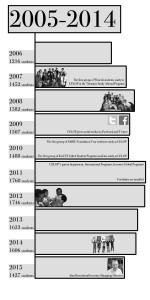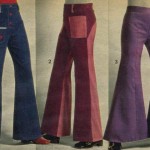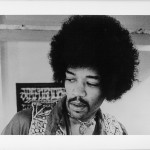by Koji Sonoda
In early summer, with a pleasant breeze blowing, there is a memorial garden in the quiet residential area surrounded by beautiful woods. The garden is named “Sugihara Memorial Garden.” It stands on the grounds of the Jewish synagogue Temple Emeth in Chestnut Hill, located five miles southwest of Boston University.
The memorial, made of black stone, was engraved in both English and Japanese and has the following inscription: “CHIUNE SUGIHARA, Japanese Consul to Lithuania...He issued some 2,000 visas to 6,000 Jews. Thereby saving the lives of what has today become 3 generations of 36,000 people.”
Chiune Sugihara was a Japanese diplomat during World War II and is now known as “the Japanese Schindler.” Sugihara served as Vice-Consul at the Japanese Consulate in Kaunas in Lithuania from 1939 to 1940, according to the Ministry of Foreign Affairs of Japan (MFA). During his tenure, he issued transit visas to Japan for a great number of European Jewish refugees who were persecuted by the Nazis.
Under the Nazi terror, six million Jews were killed during the Holocaust. However, thanks to Sugihara’s visas, more than 6,000 European Jews were allowed to enter Japan, and their lives were saved. As reported by the American-Israel Cooperative Enterprise, it was the second largest number of Jews saved by non-Jews during the Holocaust.
Sugihara’s visas were called “Visas for Life.”
The Case of Samuil Manski
A memorial to Sugihara was established in April, 2000. A member of Temple Emeth named Samuil Manski (1920-2011), who was one of the Jews rescued by Sugihara, was deeply dedicated to the memorial.
Manski wrote about his personal experiences in his book With God’s Help. According to the book, he was born in the town of Lida, Poland. In August 1939, Germany and the Soviet Union signed a secret non-aggression treaty. In September of that year, Germany invaded Poland and World War II started. Shortly after the German invasion, Lida was occupied by Soviet Russians. Manski was determined to leave Lida and became a refugee in January, 1940.
He headed for the Republic of Lithuania, where his cousins lived. He arrived there in danger, however, since Lithuania was also occupied by Russians and became a part of the Soviet Union. He was under Soviet rule again.
At that time, he knew about Sugihara. “Now, in the middle of the summer of 1940, we heard rumors that the Japanese Consulate in Kaunas was granting visas to Japan,” he said in his book. He applied to the Japanese Consulate for a visa.
On August 9, 1940, Manski obtained his newly issued visa. He began his long journey from Lithuania to Japan, via the Trans-Siberian Railway. On May 18, 1941, he finally arrived in his final destination, the United States.
He reviewed his experiences in his book as follows: “To this day, I am not certain why the Japanese took the trouble to issue visas to us Jewish refugees. I have heard speculation that the Japanese government was grateful for Jewish assistance in the Russo-Japanese war of 1905. Or it may have been that Consul in Kovno (Kaunas), observing the distress around him, acted out of humanitarian motives. Whatever the reason, again God was with us.”
Saving Three Generations
Sugihara’s visas saved a great number of Jews such as Manski. The Tokyo Holocaust Education Resource Center in Japan preserves the video interviews of Jews who were saved by Sugihara.
Dora Grynberg, who escaped from Poland to Lithuania, was one of the interviewees. Grynberg was pregnant during her long journey. She wanted to evacuate from Europe to the United States. However, she had not yet obtained her visa. At that time, she and her husband Oscar heard the rumor about the visas.
“Getting visas was a big hope for us,” Grynberg said in the video. After arriving in Japan, she gave birth to her baby in Kobe, Japan.
“Most of my families were killed in the Holocaust. But thanks to Sugihara, now I live a happy life with my son and grandchildren. Sugihara saved the lives of the Grynberg’s three generations, and gave me 52 years to spend with my husband Oscar,” she said.
Anguish and Risk of Issuing Visas
In the background of the “Visas for life,” Sugihara deeply struggled to make a decision whether he should issue visas to Jewish refugees or not. The biographical writing entitled “A Courageous Man, Chiune Sugihara,” compiled by the Tokyo Holocaust Education Resource Center, describes the situations in detail.
In July of 1940, hundreds of Jews who were evacuated from Poland gathered in front of the Japanese Consulate in Kaunas, Lithuania. They were hoping to escape to live in the United States to protect themselves. The only way to make it happen was to get transit visas allowing them to enter Japan. Although Sugihara wired the Ministry of Foreign Affairs of Japan (MFA) to get permission to issue visas for Jewish refugees, the MFA denied his request. As it was claimed by the Japan Center for Asian Historical Record, the MFA in those days had strict rules that transit visas should be issued only for the Jews who have permission from their final destination countries and had enough traveling expenses. The Jewish refugees gathering at the Japanese Consulate in Kaunas did not fulfil those conditions.
Sugihara was anguished about the extremely difficult circumstances, according to the text “A Courageous Man, Chiune Sugihara.”
“If I do not issue visas to Jews, they will be killed immediately. But I have to follow the instructions of the Japanese government,” he said in the writing. Sugihara was considering what to do in that situation with two days without sleep. He had the obligation to be subject to the MFA, but at the same time he did know that many Jews were captured and killed all around Europe in places that the Nazis occupied. Moreover, as Lithuania was occupied by Russians, the Soviet Union requested that Sugihara close the Japanese Consulate in Kaunas and leave the area immediately.
He eventually determined to issue visas for Jewish refugees to save their lives with only one month left to close the Japanese Consulate, and he sacrificed himself in writing visas. “He continued writing day and night without eating. He got blisters on his hands,” Yukiko, Sugihara’s wife, stated in the writing.
On August 28, 1940, the day to close the Japanese Consulate came at last. It had been one month since Sugihara started to issue visas. He continued writing visas until the moment his train left the station in Kaunas. As a result of his dedication, he eventually issued 2,139 visas for Jewish families within only a month.
In the aftermath of World War II, he had to pay the price. Due to his violation of the order from the MFA, he had no choice but to resign from the MFA and could not return to be a diplomat anymore.
However, his courage and humanity are highly praised all around the world now. Sugihara and his wife Yukiko are honored as “Righteous Gentiles,” which is a term for non-Jewish individuals who risked death to save Jews during the Holocaust.
“He was such a philanthropist that he would never abandon the Jewish refugees in front of him. His achievement is timeless even after more than 70 years have passed,” said Daisaku Kunieda, Director of Sugihara Chiune Memorial Hall in Gifu, Japan, in his phone interview. “Now the issue of refugees throughout the world is becoming more serious and severe. I hope that not only Japanese but also international people remember Sugihara’s deep humanitarianism in those days.”
Preserving the Past for the Future
Let us go back to the story of Samuil Manski, who was devoted to the memorial to Sugihara in the metropolitan Boston area.
Shortly after arriving in the United States, he went to Boston to rely on his father, who was working at a restaurant that was owned by his relatives. Manski started his new life at an apartment in Roxbury. He learned English, studied at the Evening College of Commerce at Boston University, and became a successful salesman.
“He was a strong-minded person,” says Cynthia Levitt, Executive Director of Temple Emeth. “Samuil Manski told us his experiences, and we realized Jewish people came out of Japan by Sugihara’s visas. He raised money for a memorial to Sugihara, and we have a memorial garden.”
In 2000, the ceremony to celebrate the opening of the “Sugihara Memorial Garden” was held in Temple Emeth. Mark H. Stepner, Senior Lecturer in CELOP, attended the ceremony. He still remembers Manski’s remarks now.
“He spoke about how critical and how important it was that Sugihara took a risk and helped a lot of people and wrote visas for a lot of people,” says Stepner.
Now 75 years have passed since Sugihara issued the visas for the Jewish refugees in Lithuania. However, many Jewish children in the Greater Boston area still learn about Sugihara’s visas and courageous acts in their local communities; and Japanese people sometimes visit the memorial at Temple Emeth to honor Sugihara.
“To my beloved children and grandchildren, I have written this in order to preserve the past. Without the past there can be no present and without the present there can be no future,” Samuil Manski noted in his book With God’s Help.





























